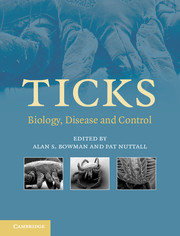Book contents
- Frontmatter
- Contents
- List of contributors
- Preface
- 1 Systematics and evolution of ticks with a list of valid genus and species names
- 2 The impact of tick ecology on pathogen transmission dynamics
- 3 Tick salivary glands: the physiology of tick water balance and their role in pathogen trafficking and transmission
- 4 Tick saliva: from pharmacology and biochemistry to transcriptome analysis and functional genomics
- 5 Tick toxins: perspectives on paralysis and other forms of toxicoses caused by ticks
- 6 Tick lectins and fibrinogen-related proteins
- 7 Endocrinology of tick development and reproduction
- 8 Factors that determine sperm precedence in ticks, spiders and insects: a comparative study
- 9 Tick immunobiology
- 10 Saliva-assisted transmission of tick-borne pathogens
- 11 Lyme borreliosis in Europe and North America
- 12 Viruses transmitted by ticks
- 13 Babesiosis of cattle
- 14 Theileria: life cycle stages associated with the ixodid tick vector
- 15 Characterization of the tick–pathogen–host interface of the tick-borne rickettsia Anaplasma marginale
- 16 Emerging and emergent tick-borne infections
- 17 Analysing and predicting the occurrence of ticks and tick-borne diseases using GIS
- 18 Acaricides for controlling ticks on cattle and the problem of acaricide resistance
- 19 Anti-tick vaccines
- 20 Anti-tick biological control agents: assessment and future perspectives
- 21 Pheromones and other semiochemicals of ticks and their use in tick control
- Index
- References
18 - Acaricides for controlling ticks on cattle and the problem of acaricide resistance
Published online by Cambridge University Press: 21 August 2009
- Frontmatter
- Contents
- List of contributors
- Preface
- 1 Systematics and evolution of ticks with a list of valid genus and species names
- 2 The impact of tick ecology on pathogen transmission dynamics
- 3 Tick salivary glands: the physiology of tick water balance and their role in pathogen trafficking and transmission
- 4 Tick saliva: from pharmacology and biochemistry to transcriptome analysis and functional genomics
- 5 Tick toxins: perspectives on paralysis and other forms of toxicoses caused by ticks
- 6 Tick lectins and fibrinogen-related proteins
- 7 Endocrinology of tick development and reproduction
- 8 Factors that determine sperm precedence in ticks, spiders and insects: a comparative study
- 9 Tick immunobiology
- 10 Saliva-assisted transmission of tick-borne pathogens
- 11 Lyme borreliosis in Europe and North America
- 12 Viruses transmitted by ticks
- 13 Babesiosis of cattle
- 14 Theileria: life cycle stages associated with the ixodid tick vector
- 15 Characterization of the tick–pathogen–host interface of the tick-borne rickettsia Anaplasma marginale
- 16 Emerging and emergent tick-borne infections
- 17 Analysing and predicting the occurrence of ticks and tick-borne diseases using GIS
- 18 Acaricides for controlling ticks on cattle and the problem of acaricide resistance
- 19 Anti-tick vaccines
- 20 Anti-tick biological control agents: assessment and future perspectives
- 21 Pheromones and other semiochemicals of ticks and their use in tick control
- Index
- References
Summary
INTRODUCTION
During the nineteenth century, as the number of cattle in the world was increased to feed the human populations of recently industrialized nations, there was a growing awareness of the relationship between infestations of cattle with ticks and disastrous epizootics of disease in herds of cattle. Problems with tick-borne diseases were related to the introduction of improved breeds of cattle into tick-infested areas because of their greater productivity than well-adapted indigenous breeds. Also, cattle infested with ticks and infected with tick-borne disease agents were moved into areas where these tick species had not previously existed (Shaw, 1969).
A severe outbreak of disease in cattle, almost certainly bovine piroplasmosis, occurred in Lancaster County, Pennsylvania, in 1796. Epidemiological evidence indicated a relationship between the disease problem and a recent shipment of cattle into the state from South Carolina, a southern state:
Experience soon showed that the invariable result following the transportation of southern cattle into the Northern States was the death of all northern cattle along the roads and on the pastures over which the southern cattle had traveled, although the latter animals remained perfectly healthy. In the same way northern cattle taken south almost invariably succumbed to the malady.
(Mohler, 1906.)The disease was called ‘Texas fever’ or ‘cattle fever’ and by 1885 resulted in the prohibition of movements of southern cattle into the northern states.
- Type
- Chapter
- Information
- TicksBiology, Disease and Control, pp. 408 - 423Publisher: Cambridge University PressPrint publication year: 2008
References
- 19
- Cited by

